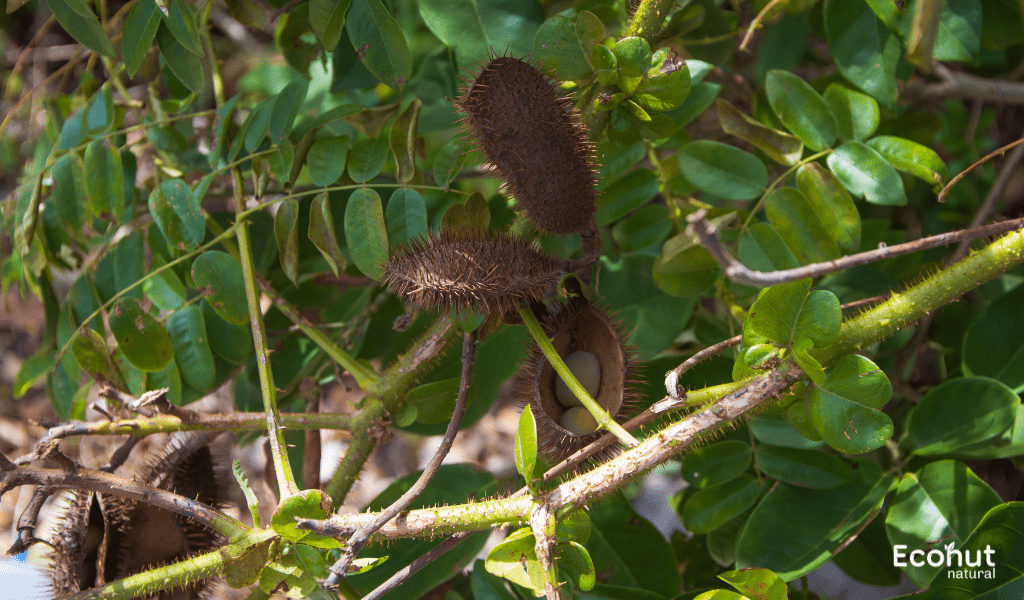Latakaranja (Caesalpinia Crista) It is also referred to as fever nut, kalarchikai, and gataran. Its seed is in various characteristics. It turns hot right away when applied to a rough surface. It also helps with a variety of fever forms. is hence called in English as “Fever nut.” It is an effective anti-spasmodic plant and is commonly used in the treatment of malaria. The eastern and southern regions of India are frequent locations for this plant.
Latakaranja is a significant herb in Ayurveda medicine. The Latakanja The strange thing about the seeds of this herb is that when they brush against a rough surface, they heat up quickly. This herb works pretty well for treating malaria.
Description
Latakaranja It is regarded as an excellent herb for treating spasms. This plant works well for treating a variety of fevers. Every portion of the plant, including the bark, seeds, roots, and leaves, has medicinal qualities. In addition to being used as a uterine stimulant to clean the uterus,this herb is also utilized in the treatment of a number of health complications, including pulmonary TB, menstrual complaints, pneumonia, malaria, and intermittent fever.
Botanical Name:
Caesalpinia Crista
Family:
Fabaceae
Leaves:
Latakaranja leaves are bi-pinnate, alternating, and frequently around one meter long. The rachis is equipped with strong, sharp, recurved spines. The leaflets are also 4-6 in number, oblong, hairy, and 2 to 5 cm long. The flowers are simple or panicled racemes, axillary, and one centimeter long.
Seeds:
The Latakaranja plant bears an oblong, inflated pod that is 5-7 cm long and coated with thin spines. It has one or two huge, slightly oval or spherical, hairy, glossy, grey seeds within. Rubbing these seeds against a rough surface is known to produce heat, making them a distinctive feature of the plant.
Roots:
Latakaranja trees have long, woody roots.
Bark:
Grey-brown in hue, the bark of the Latakaranja plant is tough.
Habitat:
It can be found from India and Sri Lanka to Queensland, New Caledonia, the Ryukyu Islands, and most of Southeast Asia. It is grown throughout the eastern and southern regions of India, particularly in the hills, forests, and sea coast. It can be found in all of India’s temperate to hot regions.
Parts Used:
- Root
- Bark
- Seeds
- leaves
Dosage:
- Powder – 1-3 g
- Juice – 10 – 20 ml
Sanskrit synonyms
Kantakikaranja – because it is aprickly shrub.
Kuberaksha – its seeds resemble the size of eyes
Putikaranja -Vitapakaranja,Karanji
Putika – Plant has fetid smell
Other Language Names of Latakaranja (Caesalpinia Crista)
Telgu name – Gachchakaya
Gujarati name – Kanchaki, Kankachia
Hindi name – Kantakareja
English name – Bonduct nut, Fever nut, Nicker tree
Malayalam name – Kalanchikkru
Tamil name – Kazhar Shikkay, Kalichchikkai
Bengali name – Natakani
Kannad – Gujugu, Gaduggu
Scientific Classification
| Kingdom | Plantae |
| Phylum | Magnoliophyta |
| Class | Angiospermae |
| Order | Fabales |
| Family | Fabaceae |
| Genus | Caesalpinia |
| Species | Crista |
Ayurvedic Properties
Hindi/Sanskrit
- Rasa -Tikta, Kashaya
- Guna -Laghu,Ruksha
- Virya -Ushna
- Vipaka -Katu
English
- Taste -Bitter,Astringent
- Physical Property-Light, Dry,
- Potency- Hot
- Metabolic Property (After Digestion)-Pungent
Latakaranja (Caesalpinia Crista) Uses
Antimalarial activity:
This herb works well to treat malaria. It aids in the management of malaria symptoms such as high fever, sweating, headaches, vomiting, diarrhea, and moderate to severe chills.
Antipyretic:
Its use is highly beneficial in treating fever because it is an antipyretic herb.
Anti-inflammatory activity:
This herb’s potent anti-inflammatory qualities aid in relieving physical discomfort.
Anxiolytic Activity:
This herb’s anxiolytic properties are highly effective in lowering anxiety, tension, stress, and depression.
Don’t miss: Danti / Red Physic Nut (Baliospermum montanum) – Uses Benefits & Side Effects
Latakaranja (Caesalpinia Crista) Benefits
Latakaranja for diabetes:
Latakaranja (Caesalpinia Crista) has numerous anti-diabetic qualities that support the body’s ability to maintain normal blood sugar levels. Additionally, it aids in the management of diabetes symptoms like weariness, weight loss, excessive thirst, and frequent urination.
Latakaranja for spasms:
The capacity of latakaranja to inhibit spasms and lessen muscle tension is another potent health benefit. This plant from Ayurveda is great for treating cramps wherever in the body. Additionally, it calms the central nervous system, which relieves psychological strain.
Latakaranja for menstrual problems:
The capacity of latakaranja to inhibit spasms and lessen muscle tension is another potent health benefit. This plant from Ayurveda is great for treating cramps wherever in the body. Additionally, it calms the central nervous system, which relieves psychological strain.
Latakaranja (Caesalpinia Crista) Side Effects
Potential gastrointestinal issues:
Some people may experience digestive disturbances with Latakaranja, such as nausea, vomiting, or diarrhea, because of specific components.
Possible pregnancy and breastfeeding:
The safety of Latakaranja during pregnancy and lactation is not well understood. It is advisable to speak with a healthcare provider before using it during these times.
Potential for allergi reactions:
Like any plant, lantakanja may cause allergies in certain people. After taking Latakaranja, if you have any adverse reactions—such as rash, itching, or trouble breathing—stop using it right away and visit a doctor.
Conclusion
Latakaranja is a significant herb used in Ayurveda medicine that has been utilized to cure a variety of illnesses. The qualities of lantakanja include anthelmintic, anti-inflammatory, analgesic, antioxidant, anti-tumor, and antimalarial effects.
FAQS
What advantages do Kalarchikai seeds offer?
According to traditional beliefs, kalachikai helps treat uterine diseases, control periods, and balance hormone levels in the body. In addition to having antibacterial, antiseptic, antifungal, and antiviral qualities, it purifies blood and controls blood sugar levels.
What is the name of Caesalpinia crista in Ayurveda?
Latakaranja, kalarchikai, Fever nut (Caesalpinia Crista)
How does one use Caesalpinia?
Rich in tannins are the fruits; flowers provide dye. Bark is employed as and abortifacient, while flower infusion is used as a pectoral and febrifuge. Leaves emmenagogue, tonic, and purgative
What are the benefits of latakaranja?
It is a crucial component of Ayush-64, an anti-malarial drug created by the AYUSH Ministry. Additionally, it works well for treating fevers of all kinds. Additionally, it aids in the management of diabetes symptoms like weariness, weight loss, excessive thirst, and frequent urination.

